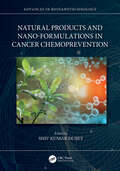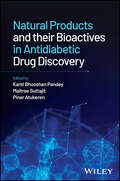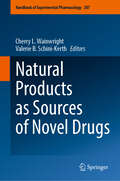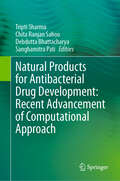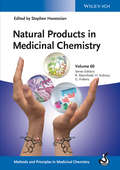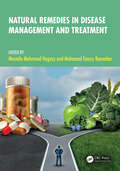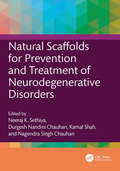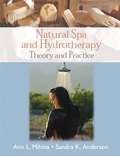- Table View
- List View
Natural Products and Nano-Formulations in Cancer Chemoprevention (Advances in Bionanotechnology)
by Shiv Kumar DubeyThis book covers various aspects of cancer chemoprevention, including an overview of chemoprevention in the process of tumorigenesis; the roles of various phytochemicals, functional foods, and dietary interventions in disease prevention; and techniques such as cancer stem cell targeting, nano-formulations, and so forth. The nutrigenomic and epigenetic effects of natural products at the molecular and genetic levels are also covered alongside their potential for additive and synergistic effect, as well as overcoming drug resistance. The key selling features of the book are as follows: Discusses holistic and comprehensive areas of chemoprevention Includes diverse techniques, such as cancer stem cell targeting, nano-formulations, and nanotechnology-based drug delivery systems Introduces various mechanisms involved in prevention of the diseases, including targeting cancer stem cells Reviews various aspects which can reduce the toxicity and cost of treatment of diseases by alternative medicine Explores various sources, mechanisms, and ways to develop cancer chemopreventive agents with minimal toxicity compared to traditional cancer therapy drugs This book is focused on researchers and graduate students in drug delivery and formulation, nanobiotechnology, cancer chemoprevention, prevention, and therapeutics.
Natural Products and their Bioactives in Antidiabetic Drug Discovery
by Kanti Bhooshan Pandey Maitree Suttajit Pinar AtukerenNatural Products and their Bioactives in Antidiabetic Drug Discovery Enables researchers to effectively understand and use bioactive compounds to target, prevent, and manage diabetes Natural Products and Their Bioactives in Antidiabetic Drug Discovery provides readers with an overview of recent research in new drug discovery against diabetic complications based on bioactives from NPs, bridging the gap between the public research institutes and private companies working to find drugs to treat diabetes. To aid in reader comprehension, the text includes case studies and illustrated examples in relevant chapters. Part one presents chapters on fundamental concepts of diabetes mellitus (DM) and recent drug discovery progress along with the various druggable targets and challenges. Part two covers bioactive compounds targeting Type-1 Diabetes. Part three focuses on Type-2 Diabetes. In Part four, the contributors address gestational DM prevention and management with natural compounds. Written by a global team of experts in the field, Natural Products and their Bioactives in Antidiabetic Drug Discovery covers sample topics such as: Obesity risk factor in patients with T1DM and possible role of nutritional therapy in its management Use of natural non-insulin drugs as a novel approach to enhance therapeutic outcomes against T1DM Effectiveness of functional foods in intervening the diabetic complications and realistic results in clinical trials Implementation of nanotechnology in improving the bioavailability and reducing the threshold dose of bioactive compounds Various antidiabetic mechanisms of action of different polyphenols and immunomodulatory role of NPs bioactives relevance in T1DM therapy Effects of natural products on genetics of gestational diabetes With comprehensive coverage of recent research in new drug discovery against diabetic complications based on bioactives from NPs, Natural Products and Their Bioactives in Antidiabetic Drug Discovery is an essential resource for researchers and professionals involved in drug discovery and development, health care, medicinal chemistry, phytochemistry, plant science, and toxicology.
Natural Products as Enzyme Inhibitors: An Industrial Perspective
by Ravindra H. Patil Vijay L. MaheshwariThis book provides an overview of the latest developments and future challenges in enzyme inhibitor research. It discusses the general enzyme inhibitory principles and mechanisms in enzyme activity regulation and application of enzyme inhibitors in different areas and sectors. The major areas of applications of enzyme inhibitors covered in this book are human health management, agriculture, food processing and research, which leads to drug discovery or enzyme activity mechanisms. The book also identifies the gaps in the existing knowledge and opens up new research ideas in this important area. Currently, most enzyme inhibitors are reported to inhibit various classes of enzymes. These enzyme inhibitors are the focus of the scientific community because they may answer an increasing array of questions in the research area of biological sciences, including biochemistry, medicine, physiology, pharmacy, agriculture, ecology etc. It also serves as a useful tool in the study of enzyme structures and reaction mechanisms and in the development of technologies in agriculture, food processing, and health management. Chapters in this book cover topics such as plant-derived inhibitors of serine proteases, pancreatic lipase (PL) inhibitors from indigenous medicinal plants, amylase inhibitors and their applications in agriculture and food processing industries and advances in silico techniques used in the study of enzyme inhibitors. The book will serve as a valuable resource for students and researchers in Life Sciences, agriculture, medicine, food processing, and allied industries.
Natural Products as Source of Molecules with Therapeutic Potential: Research And Development, Challenges And Perspectives
by Valdir Cechinel FilhoThis book addresses the highly relevant and complex subject of research on drugs from natural products, discussing the current hot topics in the field. It also provides a detailed overview of the strategies used to research and develop these drugs. Respected experts explore issues involved in the production chain and when looking for new medicinal agents, including aspects such as therapeutic potential, functional foods, ethnopharmacology, metabolomics, virtual screening and regulatory scenarios. Further, the book describes strategic methods of isolation and characterization of active principles, biological assays, biotechnology of plants, synthesis, clinical trials and the use of tools to identity active principles.
Natural Products as Sources of Novel Drugs (Handbook of Experimental Pharmacology #287)
by Cherry L. Wainwright Valerie B. Schini-KerthThis book reflects the state of the art in the field of natural product drug discovery. The work explores what advances have been made in discovering novel compounds from terrestrial, marine and microbial sources for use in the treatment and management of both non-communicable (e.g. cardiovascular, neurodegenerative) and communicable (e.g. malaria) diseases. Each chapter is authored by international experts who present detailed analysis of the pipeline of natural product-derived drugs in their field. This book makes a valuable contribution to the field and appeals to researchers in all branches of natural product research.
Natural Products for Antibacterial Drug Development: Recent Advancement of Computational Approach
by Tripti Sharma Chita Ranjan Sahoo Debdutta Bhattacharya Sanghamitra PatiThe book focuses on the rampant use of higher-dose antibiotics in human routine consumption and how it leads to bacterial resistance to multiple drugs. Book chapters focus on the result of their overuses and concomitant misuses, and how antibiotics have become synonymous with the unending hellish experience that is antimicrobial resistance by pathogenic microbes. It also talks about the challenges associated with the treatment of bacterial infections and challenges to mankind due to the development of high rates of antibiotic resistance. This book also provides information about developments of antibacterial drugs from natural sources. In addition, it also covers different computational approaches used for antibacterial drug development from natural sources in recent times. Finally, the book also elucidates a detailed outline of bacterial resistance status, current treatment methods, natural products as an opportunity for the development of potent druggable candidates, and methods of antibacterial drug development. This book serves as a great resource for students, researchers, and academicians in the field of pharmacology.
Natural Products for Cancer Chemoprevention: Single Compounds and Combinations
by John M. Pezzuto Ole VangThis book discusses the efficacy of various naturally occurring chemopreventive agents in preventing or delaying cancer. It focuses on the holistic chemopreventive concept, demonstrating the relevant response is the combined effect of a series of compounds that alone have been shown to have some effect in different experimental models. Written by leading experts in the field, the contributions provide details of research on various chemopreventive agents. Offering insights into the unique molecular targets and mechanisms, safety issues, molecular efficacy, and occurrence in nature of these compounds, the book is a valuable resource for all scientists working in biomedicine, and specifically in cancer research.
Natural Products from Actinomycetes: Diversity, Ecology and Drug Discovery
by Jamuna A. Bai Ravishankar V. RaiThis book provides in-depth information about the ecology, diversity and applications of Actinomycetes. The book is divided into two major parts. The first part discusses the diversity, chemical biology and ecology of Actinomycetes. It also covers the discovery of natural products from soil, endophytic and marine-derived Actinomycetes. It includes natural product discovery, chemical biology, new methods for discovering secondary metabolites, structure elucidation and biosynthetic research of natural products. The chapters in this part focus on the effects of biological and chemical elicitation at molecular level on secondary metabolism in Actinomycetes. The second part of the book discusses genomic and synthetic biology approaches in Actinomycetes drug discovery. This part includes chapters focused on the application of metabolic engineering to optimize natural product synthesis and the use of omics data in engineering of regulatory genes. It covers the advanced tools of synthetic biology and metabolic engineering including cluster assembly, CRISPR/Cas9 technologies, and chassis strain development for natural product overproduction in Actinomycetes. It describes the use of bioinformatics tools for reprogramming of biosynthetic pathways through polyketide synthase and non-ribosomal peptide synthetase engineering. These advanced genomic and molecular tools are expected to accelerate the discovery and development of new natural products from Actinomycetes with medicinal and other industrial applications. The book is useful to researchers and students in the field of microbiology, pharmaceutical sciences and drug discovery.
Natural Products in Beverages: Botany, Phytochemistry, Pharmacology and Processing (Reference Series in Phytochemistry)
by Jean-Michel Mérillon Céline Rivière Gabriel LefèvreThis reference book provides an overview of the active ingredients of selected plants present in beverages. The book aims to highlight according to the chapters the botanical, ethnobotanical, ecological or agronomic aspects of these botanical species used in some well-known or rarer beverages by linking them to their phytochemistry. This book also covers the manufacturing techniques, as well as the quality control of these products of natural origin in beverages. The content is divided into five main sections containing chapters written by valuable experts in their field : (1) beverages plants with caffeine and other methylxanthines, (2) beverage plants without caffeine, (3) fruits juices, (4) alcoholic beverage plants: non-distilled beverages and (5) alcoholic beverage plants: distilled beverages. The book is a useful resource for graduate students, academics and researchers in the field of botany, agriculture, food chemistry, nutrition as well as for industrial scientists and those involved in the commercialization of phytochemicals, plants and their extracts.
Natural Products in Cancer Prevention and Therapy
by John M. Pezzuto Nanjoo SuhChemoprevention of Esophageal Squamous Cell Carcinoma with Berries, by Gary D. Stoner and Li-Shu Wang Cancer Prevention by Different Forms of Tocopherols, by Chung S. Yang and Nanjoo Suh Cancer Chemopreventive and Therapeutic Potential of Guggulsterone, by Inas Almazari and Young-Joon Surh Inhibition of UVB-Induced Nonmelanoma Skin Cancer: A Path from Tea to Caffeine to Exercise to Decreased Tissue Fat, by Allan H. Conney, You-Rong Lou, Paul Nghiem, Jamie J. Bernard, George C. Wagner and Yao-Ping Lu Cancer Chemoprevention and Nutri-Epigenetics: State of the Art and Future Challenges, by Clarissa Gerhauser A Perspective on Dietary Phytochemicals and Cancer Chemoprevention: Oxidative Stress, Nrf2, and Epigenomics, by Zheng-Yuan Su, Limin Shu, Tin Oo Khor, Jong Hun Lee, Francisco Fuentes and Ah-Ng Tony Kong Keap1-Nrf2 Signaling: A Target for Cancer Prevention by Sulforaphane, by Thomas W. Kensler, Patricia A. Egner, Abena S. Agyeman, Kala Visvanathan, John D. Groopman, Jian-Guo Chen, Tao-Yang Chen, Jed W. Fahey and Paul Talalay Chemoprotection Against Cancer by Isothiocyanates: A Focus on the Animal Models and the Protective Mechanisms, by Albena T. Dinkova-Kostova Human Cancer Chemoprevention: Hurdles and Challenges, by Vaqar Mustafa Adhami and Hasan Mukhtar Personalizing Lung Cancer Prevention Through a Reverse Migration Strategy, by Kathryn A. Gold, Edward S. Kim, Ignacio I. Wistuba and Waun K. Hong Natural-Agent Mechanisms and Early-Phase Clinical Development, by Janet L. Wang, Kathryn A. Gold and Scott M. Lippman
Natural Products in Medicinal Chemistry
by Gerd Folkers Hugo Kubinyi Stephen HanessianThe inspiration provided by biologically active natural products to conceive of hybrids, congeners, analogs and unnatural variants is discussed by experts in the field in 16 highly informative chapters. Using well-documented studies over the past decade, this timely monograph demonstrates the current importance and future potential of natural products as starting points for the development of new drugs with improved properties over their progenitors.The examples are chosen so as to represent a wide range of natural products with therapeutic relevance among others, as anticancer agents, antimicrobials, antifungals, antisense nucleosides, antidiabetics, and analgesics.From the content:* Part I: Natural Products as Sources of Potential Drugs and Systematic Compound Collections* Part II: From Marketed Drugs to Designed Analogs and Clinical Candidates* Part III: Natural Products as an Incentive for Enabling Technologies* Part IV: Natural Products as Pharmacological Tools* Part V: Nature: The Provider, the Enticer, and the Healer
Natural Products in Obesity and Diabetes: Therapeutic Potential and Role in Prevention and Treatment
by Biswanath DindaThis book provides a detailed summary of the therapeutic benefits of natural extracts from medicinal plants, mushrooms, algae, fungi and sponges and their role in the prevention and treatment of obesity and diabetes, offering readers a solid introduction to obesity and diabetes as well as current treatment models. In addition, it examines how genomics and multi-omics approaches have revolutionized our understanding of these diseases, and discusses the role of microbiome-host interactions, probiotics, prebiotics and the future of metabolic phenotyping.Focusing on the pharmacokinetics of anti-obesity and anti-diabetic phytochemicals, their bioavailability in the respective target tissues and their elimination times, the book also describes the nanoformulations of phytochemicals and herbal extracts. Lastly, it presents an overview of the advances in clinical studies on the use of herbal and mushroom extracts in obesity and diabetes management.Given its scope, this book is useful not only for researches in the field but also for students studying nutrition, food sciences, plant sciences or pharmacology, as well as for health professionals and practitioners.
Natural Products in the Chemical Industry
by Bernd SchaeferNatural Products in the Chemical Industry is not a conventional textbook, but rather an invitation to join an entertaining journey that takes you into the fascinating world of natural products. This book features diverse compound classes from a number of areas: colourants, fragrances and flavourings, amino acids, pharmaceuticals, hormones, vitamins and agrochemicals. Whether you are a teacher or a scholar, an undergraduate or graduate student, a professional chemist in industry or academia, or someone just interested in natural sciences, this book allows you to be inspired and entertained by facts and information along with enjoyable anecdotes, historical, economic, political, biological and social considerations. Experts in the field can have a pleasurable time cruising through captivating synthesis methods, which enable the generation of complex molecules on industrial scale.This book · deals with the manufacturing of larger quantities of complex molecules (asymmetric and heterocyclic compounds, polycyclic structures, macrocycles and small rings) · displays all reaction schemes in colour, which makes them easy to read · highlights aesthetics and elegance in modern industrial organic chemistry
Natural Relief for Anxiety: Complimentary Strategies for Easing Fear, Panic, and Worry
by Lorna Garano Edmund J. Bourne Arlen BrownsteinBack Cover: "Twenty-five million Americans suffer from diagnosable anxiety disorders, and millions more struggle with occasional feelings of fear, panic, and worry. Pharmaceutical companies spend billions each year developing drugs to counteract these feelings, but the truth is that there is no "magic pill" that can make anxiety go away. Anxiety treatments that rely on medication have a high incidence of relapse when the medication stops. And the side effects of these drugs can be more debilitating than the condition they were designed to treat. An alternative and more lasting way to control anxiety is to make gentle, natural changes to your lifestyle that promote wellness in mind and body. Written by the best-selling author of The Anxiety and Phobia Workbook and a naturopathic physician, this book offers you a complete strategy for overcoming anxiety without drugs. Begin by taking a look at the choices you make every day about your lifestyle and general well-being. Calm your anxious mind with healthy self-talk. Learn the importance of exercise and a healthy, natural diet in controlling anxiety. Discover techniques that promote deep physical relaxation. Find out which nutritional supplements and natural therapies can help you on your way to renewed peace of mind. Explore ways you can simplify your life to reduce stress. The book offers a broad range of self-care resources as well as information about how and when to seek outside help. Complementary treatment approaches: * Relaxation, exercise, and diet improvement * Herbs and nutritional supplements * Massage and bodywork * Chiropractic care * Mindfulness meditation, yoga, and t'ai chi * Homeopathic and naturopathic medicine," and spirituality.
Natural Remedies for Mental and Emotional Health: Holistic Methods and Techniques for a Happy and Healthy Mind
by Chrystle Fiedler Brigitte MarsA self-care guide to treating mental, emotional, and neurological conditions• Explores common mental health concerns and stress-related issues—such as anxiety, depression, anger, insomnia, brain fog, and trauma—and shares remedies and practices to address and heal their root causes • Examines the influence of diet and nutrition on mental health and the benefits of specific foods, herbs, supplements, essential oils, and self-care techniques • Details holistic remedies for neurological conditions, such as ADHD, epilepsy, addiction, bipolar disorder, PTSD, multiple sclerosis, Parkinson&’s disease, traumatic brain injury (TBI), and stroke Mental health and emotional well-being are just as important as physical health. And like physical health, there are many simple ways to improve and support mental wellness with the healing power of herbs and other holistic remedies and practices. In this comprehensive guide to natural methods to maintain a healthy mind, herbalist Brigitte Mars and natural health expert Chrystle Fiedler explore many common mental health concerns and stress-related issues—such as anxiety, depression, panic attacks, anger, insomnia, brain fog, and trauma—and share remedies and practices to address and heal their root causes. Citing recent medical studies, they examine the influence of diet and nutrition on mental health concerns and explore the benefits of specific foods, herbs, supplements, essential oils, and self-care techniques like acupressure, massage, and color therapy. The authors also explore holistic practices and treatments for moving through grief, breaking free from addiction, working with ADHD and epilepsy, supporting chronic conditions like bipolar disorder, PTSD, and Parkinson&’s disease, and recovering from traumatic brain injury (TBI) and stroke. Presenting a wealth of holistic self-care therapies for mental well-being, emotional balance, and neurological health, this guide enables each of us to heal the mind and nurture the soul, two essential keys to a happy, joyful life.
Natural Remedies for Sleep: Essential Oils, Meditation, Acupressure, and More for a Good Night's Rest
by Kye PevenDiscover non-pharmaceutical solutions for better sleepA good night's sleep can do wonders for your physical and mental health. But if you struggle with falling or staying asleep, your frustration may have you looking to sleep medicine for help. This natural remedies book will show you a better way. Natural Remedies for Sleep provides the knowledge, tools, and natural solutions for how to sleep smarter. Explore why we sleep, along with cognitive behavioral therapy (CBT) techniques, meditation, essential oils, acupressure, and more to help you get the full, consistent rest you deserve.Sleep 101—Learn the basics of what good sleep is, why we need it, some common sleep issues, and the short- and long-term benefits of a dependable night's sleep.Sleep tool kit—Good sleep takes planning—discover a list of the resources and items you need for getting a better night's sleep, and creating a smart sleep routine for yourself.Sleep scenarios—Find suggested natural sleep remedies for adults and techniques for overcoming a range of sleep problems and scenarios, such as insomnia, interrupted sleep patterns, and digestion issues.Fall asleep and stay asleep with the helpful and all-natural techniques and resources in this empathetic book.
Natural Remedies from Around the World: Cures for 300 Common Ailments
by John HeinermanRenowned medical researcher Dr. John Heinerman has been travelling the world for three decades, searching out the remedies perfected by shamans and healers, doctors and scientists. Now he compiled them all for you in Natural Remedies from Around the World. Arranged alphabetically by ailment for easy access, Natural Remedies from Around the World delivers effective, all-natural medicines grounded in revered healing traditions. Fighting the flu? Try a goat's-milk-and-onion cure that's been felling the flu in Iran for centuries. Indigestion? Have a cup of Brigham Young's Composition Tea, a pick-me-up enjoyed by Mormons since the 1840s. Want to get rid of your "crow's feet"? Try this vinegar trick from Hungary. Troubled by recurring boil or cyst? Discover a fruit cure popular among South Sea Islanders. Asthma? Try a life-saving cure discovered in a remote Turkish village.
Natural Remedies in Disease Management and Treatment
by Mohamed Fawzy Ramadan Mostafa Mahmoud HegazyThis book explores the preclinical and clinical aspects of herbal remedies, focusing on common diseases treated and managed with natural solutions. It includes comprehensive information on diseases and their most suitable natural remedies, discussing active constituents, pharmacological activities, molecular mechanisms, dosage forms, precautions, contraindications, and adverse effects based on clinical evidence.Key Features: Detailed information on the pharmacokinetics and pharmacodynamics of natural remedies is provided to ensure the selection of the most appropriate treatment for the disease Emphasis is placed on clinical evidence to guide safe and effective prescription of natural remedies and the development of new pharmaceutical products Insights into future challenges in the field, such as standardization and the development of new product formulas, are given, and summaries of the current state of research in key topic areas for the community are provided Authored by a team of scientists and experts, Natural Remedies in Disease Management and Treatment brings together diverse developments in the fields of medicine, pharmacognosy, herbal drug chemistry, pharmacology, pharmaceuticals, and cosmetics. It is an indispensable guide for scientists, pharmacists, physicians, nurses, medical students, and herbalists.
Natural Remedies: A Step-By-Step Guide to Making and Using Herbal Medicines
by Mária Tránsito López Luengo Carlota Mañez ArisóDiscover how to grow medicinal plants and create natural remedies right in your own home. Although more and more people use medicinal plants, many are still unaware of those that are usually present in their own homes. For example, did you know that cranberries are effective in treating bladder problems, that olive helps regulate blood pressure, or that hops promote sleep in children? In Natural Remedies, you will find a selection of plants from which you can create natural remedies for every occasion. Learn how to grow and use these medicinal plants, and discover what they can do to boost your family&’s health. More than one hundred types of natural plants are presented in this book, grouped by the conditions that they most effectively treat. You will also discover: Essential remedies to have while travelingThe most useful plants and spices to have in the kitchenThe best plants for respiratory, digestive, tension-related, circulatory, and hepatic concerns With more than 350 color images, Natural Remedies is an essential resource for those looking to grow medicinal plants and create their own natural remedies.
Natural Remedies: Their Origins and Uses
by Desmond Corrigan Finn SandbergThe past two decades have witnessed a phenomenal explosion of interest in the potential uses of plant medicines in healthcare and this has evoked the rebirth of pharmacognosy. This volume is unique in that it is the first, in English, to employ the Anatomical, Therapeutic and Chemical (ATC) classification system, developed by the World Health Organ
Natural Scaffolds for Prevention and Treatment of Neurodegenerative Disorders
by Durgesh Nandini Chauhan Nagendra Singh Chauhan Kamal Shah Neeraj K. SethiyaNeurodegenerative diseases affect millions of people worldwide and are a group of several diseases with distinct pathology, physiology, prevention, and treatment strategies. Recently, natural products especially derived from medicinal plants are gaining momentum to manage neurodegenerative disease safely and effectively. Therefore, there is an urgent need to provide a ready roadmap for scientifically validated value-added nutraceutical and pharmaceutical safe and effective product for the management of various neurodegenerative diseasesNatural Scaffolds for Prevention and Treatment of Neurodegenerative Disorders will provide compiled information stating several identified neurodegenerative diseases including pathology and physiology. From vast literature on natural products, such asscientifically validated plant bioactives, traditional approaches to combat or prevent neurodegenerative conditions are also included along with molecular mechanisms. The book will further specify: Single window complied information on various neurodegenerative diseases. Possible projection of bioactivity from natural resources to each category of neurodegenerative diseases. Ready-to-use reference material to develop several value-added products or proceed to the next level. The book will be very useful for nutraceutical research groups, education institutions, and industries focusing on developing value-added solutions for the management of several neurodegenerative diseases.
Natural Secondary Metabolites: From Nature, Through Science, to Industry
by Lillian Barros Márcio Carocho Sandrina A. HelenoThis book focuses on the different compounds (polyphenols, sterols, alkaloids terpenes) that arise from the secondary metabolism of plants and fungi and their importance for research and industry. These compounds have been the backbone and inspiration of various industries like the food, pharmaceutical and others to produce synthetic counterparts. Furthermore, many of these compounds are still widely used to carry out specific functions in all these industries. This book offers a compilation of different texts from world leading scientists in the areas of chemistry, biochemistry, plant science, biotechnology which compile information on each group of secondary metabolism compounds, and their most important applications in the food, pharmaceutical, cosmetic and textile industry. By showcasing the best uses of these compounds, the chemistry behind their production in plants and fungi, this book is a valuable resource and a "go to" artifact for various audiences. The new approach this book offers, by linking research and the application of these compounds, makes it interesting as an inspiration for new research or as a hallmark of what has been done in the secondary metabolism of plants and fungi in recent years. Although this book may be technical, it is also enjoyable as an integral reading experience due to a structured and integrated flow, from the origins of secondary metabolism in organisms, to the discovery of their effects, their high intensity research in recent years and translation into various industries. Beyond learning more on their chemistry, synthesis, metabolic pathway, readers will understand their importance to different research and industry.
Natural Small Molecule Drugs from Plants
by Guan-Hua DuThis book discusses 120 types of natural, small-molecule drugs derived from plants. They are grouped into 7 parts according their clinical uses, such as drugs for cardiovascular diseases, for metabolic diseases, for neuropsychiatric diseases, for immune-mediated inflammatory diseases, anti-tumor drugs, and drugs for parasites and bacterial infection. Each chapter systematically summarizes one drug, including its physicochemical properties, sources, pharmacological effects and clinical applications. To help readers understand the drug better, the research and pharmacological activity for each drug is also described, which serves as a salutary lesson for future drug development. Written by frontline researchers, teachers and clinicians working in field of pharmacy and pharmacology it provides an overview of natural, small-molecule drugs derived from plants for researchers in the field.
Natural Spa and Hydrotherapy: Theory And Practice
by Sandra Anderson Ann MihinaThe recent growth of the spa industry has resulted in a need for highly educated practitioners of spa and hydrotherapy treatments. Natural Spa and Hydrotherapy: Theory and Practice is designed to meet the needs of today's spa practioners. This book can be used for spa training as well as for skill enhancement for individual therapists. It will assist students of massage and bodywork as well as practitioners in spa settings and private practice who have the desire to increase their knowledge and understanding of, and competency in, natural spa and hydrotherapy.
Natural Substances for Cancer Prevention
by Jun-Ping XuNatural Substances for Cancer Prevention explores in detail how numerous investigations in chemical biology and molecular biology have established strong scientific evidence demonstrating how the properties of naturally occurring bioactive chemicals hamper all stages of cancers (from initiation to metastasis). Accordingly, important goals for cancer prevention are the modification of our dietary habits and an increase in the intake of more anticancer-related natural substances. More significantly, the bioactive chemicals presented in the functional foods should be readily available, inexpensive, non-toxic, and nutritional.
